Works of Art

One of the six chandeliers supplied to Kensington Palace, now in the V&A, London (W.28-1959)

William Henry Pyne, Kensington Palace, The Queen’s Gallery (London, 1819), showing four of the set of six giltwood chandeliers in situ

Daniel Marot, Nouveaux Livre d’Orfevrerie Inventé Par Marot Architecte du Roy fait avec Previllege des États Generax des Provinces Unie, 1701-3

The chandelier photographed in the drawing room at Duke Farms, Doris’ home in New Jersey
A QUEEN ANNE GILTWOOD AND GILT-METAL CHANDELIER
D: 91.5cm
Further images
-
(View a larger image of thumbnail 1
)
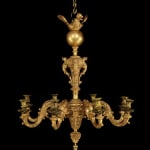
-
(View a larger image of thumbnail 2
)
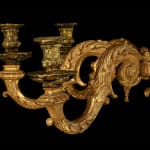
-
(View a larger image of thumbnail 3
)
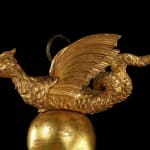
-
(View a larger image of thumbnail 4
)
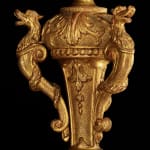
-
(View a larger image of thumbnail 5
)
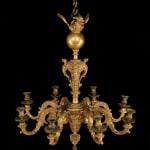
-
(View a larger image of thumbnail 6
)
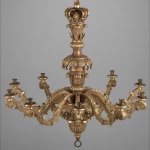
-
(View a larger image of thumbnail 7
)
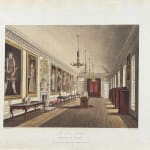
-
(View a larger image of thumbnail 8
)
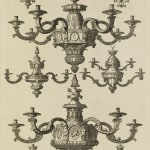
-
(View a larger image of thumbnail 9
)
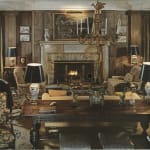
Provenance
Redburn Antiques, London, 1 April 1971 (inv. no. 27A)
The Collection of Doris Duke, Christie’s, New York, 15 April 2005, lot 145, USD 102,000
Ronald Phillips Ltd., London
Albany, An Important Private Collection, Sotheby's, London, 6 December 2023, lot 31, GBP 120,650
Literature
Desmond Fitzgerald, Georgian Furniture (London, 1969), no. 17
Victoria and Albert Museum, Fifty Masterpieces of Woodwork (London, 1955), No. 38
Hans Ottomeyer and Peter Pröschel, Vergoldete Bronzen: Die Bronzearbeiten des Spätbarock und Klassizismus (Munich, 1986), vol. I, p. 54, fig. 1.6.10
Publications
Ronald Phillips Ltd., Catalogue (London, 2006), p. 220
English giltwood chandeliers of this period and quality are exceedingly rare.
The present example is analogous to a set of six supplied for the Queen’s Gallery at Kensington Palace (Fig. 2.), likely by royal cabinet-makers James Moore and John Gumley. Remaining at the Palace until the late nineteenth century, after which three were acquired by Sir Spencer Ponsonby-Fane for Brympton d’Evercy, Somerset and then sold in 1956, one of the chandeliers is now in the collection of the Victoria and Albert Museum, London (W.28-1959), on loan to Kensington Palace.1
A further pair, also attributed to Moore and Gumley, was supplied for the State Apartments at Holme Lacy, Herefordshire. One chandelier sold at Christie’s on 21 April 1995, lot 243 ($715,000) and now hangs in the Kirtlington Park dining room installed at the Metropolitan Museum of Art, New York (1995.141).
Another exceptional giltwood chandelier, also in the V&A (416:1 to 10-1882), though of c. 1740 and attributed to William Kent, bears stylistic relation to the present example, being a developed Palladian form of the present Baroque design, though sharing design elements with the earlier model, such as an acorn finial.2 A chandelier of the same period, attributed to Henry Flitcroft and Matthias Lock, originally supplied to St. Giles House, formed part of the collection of Ann and Gordon Getty and sold Christie’s, New York, 20 Oct 2022 lot 45, USD 441,000.
A final related giltwood chandelier, of the same period as the present example and likewise attributable to Moore, is in the King’s Eating Room in Hampton Court Palace Eating Room in Hampton Court Palace (RCIN 1018).
The design of the chandelier and the small English group of which it is part derives from the arabesque forms of the Louis XIV and Régence periods. Hans Ottomeyer and Peter Pröschel illustrate analogous French chandeliers in Vergoldete Bronzen, including a set of four by André-Charles Boulle in the Bibliothèque Mazarine that relates closely to the present chandelier.3 Another Boulle gilt-bronze example is in the V&A (965-1882).
Figures such as Daniel Marot, a Huguenot designer and religious émigré, brought the style to English makers in London. He published designs for chandeliers in this style in his Nouveau Livre d’Orfevrie Inventé par Marot, Architecte du Roy […] in 1701-3 (Fig. 3.), which English makers interpreted with the purity, restraint and refinement demanded by English taste. French models were executed in gilt-bronze whereas English chandeliers were made in giltwood and appear to survive in fewer numbers than their counterparts across the Channel.
The magnificent wyvern surmounting the chandelier is likely an heraldic device. Wyvers are associated with numerous families, but the most notable is that of Herbert, of which the most prominent members during this period were William, 2nd Marquess of Powis (1665-1745) and Thomas, 8th Earl of Pembroke (1656-1733), for whom the chandelier may have been made.
The richness of the chandelier is represented in its later history of ownership. From the early 1970s until 2005 the chandelier was in the collection of Doris Duke (1912-1993), dubbed from the day she was born ‘the richest girl in the world’, being the heiress of her father’s business empire. She went on to lead a colourful life of philanthropy, adventure and art collecting.
1 D. Fitzgerald, Georgian Furniture (London, 1969), no. 17
2 Victoria and Albert Museum, Fifty Masterpieces of Woodwork (London, 1955), No. 38
3 Hans Ottomeyer and Peter Pröschel, Vergoldete Bronzen: Die Bronzearbeiten des Spätbarock und Klassizismus (Munich, 1986), vol I, p. 54, fig. 1.6.10




